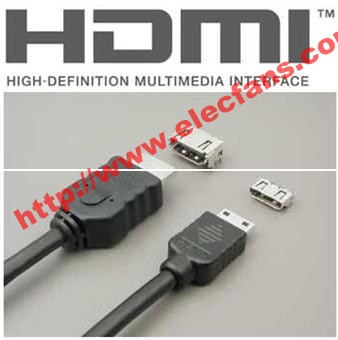what is hdmi
The full name of HDMI is "High DefiniTIon MulTImedia Interface". In April 2002, seven companies from the electronics and electronics industry-Hitachi, Panasonic, Philips, Silicon Image, Sony, Thomson, and Toshiba jointly established the HDMI High Definition Multimedia Interface Interface Organization HDMI Founders (HDMI Forum), and began to develop a A new digital video / audio interface technology that meets the standards of the high-definition era. After more than half a year of preparation work, HDMI founders officially released the HDMI 1.0 version standard on December 9, 2002, marking the official entry of HDMI technology into the historical stage.
The introduction of HDMI technology is not an impulsive behavior of these manufacturers, but on the contrary, there are more deep-seated reasons behind the introduction of HDMI technology.
In April 1999, in order to meet the requirements of high-quality graphics and images in the digital era, the DDWG (Digital Display Working Group) digital display working group based on the US Silicon Image patented technology as a model, launched a name called DVI (Digital Visual Interface) The interface is designed to unify the digital display interface standard of the new era. This technology has also been widely supported by large companies such as INTEL, DELL, HP, IBM, and Microsoft in the IT industry. After more than three years of promotion, DVI technology has been rapidly used in the field of computer display output. However, with the development of digital high-definition audio and video technology, the DVI interface has gradually exposed various problems, and has even become a degree of progress in digital imaging technology bottleneck.

The main features and advantages of the HDMI standard
At the beginning of the formulation of the HDMI standard, some of the relatively mature and relatively easy-to-implement technical standards in the DVI standard were not abandoned. The entire transmission principle is still based on Silicon Image's TMDS encoding technology. As for the various defects of the DVI interface, HDMI has been greatly improved, mainly reflected in the following aspects:
* Better anti-jamming performance, can achieve a gain-free transmission of up to 20 meters.
* Optimized for the resolution of large-size digital flat-panel TVs with good compatibility.
* Support EDID (Note 1) and DDC2B (Note 2) standards, the best matching connection method can be intelligently selected between devices.
* Has a powerful copyright protection mechanism (HDCP) to effectively prevent piracy.
* Support 24bit color depth processing (RGB, YCbCr4-4-4, YCbCr4-2-2).
* The interface is small, and various devices can be easily installed.
* One cable realizes synchronous transmission of digital audio and video signals, effectively reducing the cost and complexity.
* Fully compatible with the DVI interface standard, users do not need to worry about the mismatch between the old and new systems.
* Support hot plug technology.
Note 1: EDID (Extended Display IdenTIficaTIon DATA, or Extended Display Identification Data), was originally a specification designed for the optimized display format set for PC monitors and is stored in the dedicated EEROM memory of 1Kb in the monitor. The HDMI interface complies with and extends this specification. The biggest difference between the EDID data structure of the HDMI interface in the digital TV and the PC display is that the programming data can be a multiple of 128Byte. It not only specifies the format of the digital TV display, but also specifies the digital video signal and digital audio signal.
Note 2: DDC2B is a protocol standard for quasi-bidirectional communication between the host and the display device, which is mainly based on the I2C communication protocol. Only after the host sends a demand signal to the display device and gets a response from the display, the display device will send EDID data like the host.
The above only lists the main advantages of HDMI technology over DVI technology, and with the development of the HDMI standard itself, it has evolved from the initial 1.0 version to 1.2 and 1.3 subsequent versions, not only the performance is more powerful, but also the compatibility is more outstanding. Therefore, HDMI is becoming the most popular digital interface in the era of high-definition. On any flat panel TV now, the HDMI interface has become a standardized configuration.
So what kind of transmission principle does the HDMI standard use? What is the specific performance of HDMI? Now enter the second part of this article: explain HDMI technology in detail.
Fiber Optic Modem is a type of RS-232/RS-485/RS-422 serial port fiber optic modem. It adopts industrial standard design and its wall type outface design supports DIN-rail standard lead rail installation, featuring easy installation. Presently many users make use of RS-232/RS-485/RS-422 serial port fiber optic modem to solve the electromagnetic interference in engineers and to extend the RS-232/RS-485/RS-422 serial port transmission distance to several or even tens of kilometers.Fiber Optic Modem can provide users with RS-232/RS-485/RS-422 serial port end-to-end transparent transmission. Since signals are transmitted over fibers and these optical signals are free of electrical conductivity, they have strong anti-interference capacity and are immune to high-voltage power or thunders.
RS485/RS422/RS232 To Fiber Converter
RS485 To Fiber Converter,RS422 To Fiber Converter,RS232 To Fiber Converter
Shenzhen N-net High-Tech Co.,Ltd , http://www.nnetswitch.com